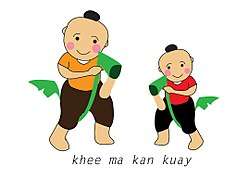Thai traditional games
There are more than 1,200 Thai traditional games. These games originated in the era of the Sukhothai Kingdom (1238-1438). Hundreds of years later, during the reign of Rama VI, the games grew popular again among Thai children. The original purpose of Thai traditional games was to form good relationships between adults and young people. They were also used as entertainment, relaxation, and exercise. Thai traditional games are played with songs and rules to make them more entertaining. Most traditional Thai games use natural, found items, like children's games everywhere. For example, sand, mud balls, and the stems of the banana trees were common components of games.[1]
Khee ma kan kuay (horse riding)

- Equipment: One metre-long banana stalk, knife, rope
- Number of players: More than two persons
- How to play: All players sit on the banana stalk like they're riding a horse and shout "hee hee" or "yee haaah". All of them have to run to the goal at the end of the racecourse. Whoever reaches the finish line first is the winner.
Dern Ka La
- Equipment: two coconut shells and rope or string (1.5 m)
- Number of players: More than two persons
- How to play: Each player stands on a coconut shell and holds the string. After standing on the coconut shell, they will start the game by walking. They have to walk as quickly as possible and whoever arrives at the finish line first is the winner.
Mon Sonpa or Mon hides a cloth
- Equipment: Cloth
- Number of players: More than three persons
- How to play: Before starting the game, players have to choose the person who will be "Mon" and then every player except the Mon will sit down on the floor in circle and sing the song "Son Pha". While all the other players sing, Mon will hold a cloth and walk around the circle. If Mon puts a cloth behind one of them, he or she must pick it up and run to catch the Mon around the circle. If the player cannot catch the Mon before the Mon sits at his or her place, the one who holds that cloth will be the next Mon for the next game.
See also
References
- Srikate, Phonphan; Nopparatteearwut, Patpimon; Tandidontanate, Ekapon; Songchan, Thanawat (2008). "Thai sports & traditional games" (pdf). Institute of International Studies. Ramhamheang University - Institute of International studies. Retrieved 12 July 2017.
External Links
This article is issued from Wikipedia. The text is licensed under Creative Commons - Attribution - Sharealike. Additional terms may apply for the media files.